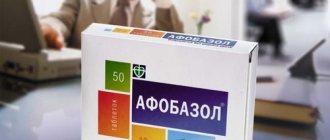Metabolic syndrome - the basis of pathogenetic therapy
In 1948, the famous clinician E.M. Tareev wrote: “The idea of hypertension is most often associated with an obese hypersthenic, with a possible disorder of protein metabolism, with blood clogging with products of incomplete metamorphosis - cholesterol, uric acid...” Thus, more than 50 years ago the idea of metabolic syndrome (MS) was practically formed. In 1988, G. Reaven described a symptom complex including hyperinsulinemia, impaired glucose tolerance, low HDL cholesterol and arterial hypertension, giving it the name “syndrome X” and for the first time suggesting that insulin resistance (IR) with compensatory hyperinsulinemia. In 1989, J. Kaplan showed that an essential component of the “deadly quartet” is abdominal obesity. In the 90s the term “metabolic syndrome” appeared, proposed by M. Henefeld and W. Leonhardt. The prevalence of this symptom complex is becoming epidemic and in some countries, including Russia, reaches 25-35% among the adult population.
Generally accepted criteria for MS have not yet been developed, presumably due to the lack of common views on its pathogenesis. The ongoing discussion about the validity of using the terms “complete” and “incomplete” MS illustrates the underestimation of a single mechanism that determines the parallel development of all cascades of metabolic disorders in insulin resistance.
IR is a polygenic pathology, in the development of which mutations in the insulin receptor substrate genes (IRS-1 and IRS-2), β3-adrenergic receptors, uncoupling protein (UCP-1), as well as molecular defects in proteins of the insulin signaling pathway (glucose transporters) may play a role. . A special role is played by a decrease in insulin sensitivity in muscle, fat and liver tissues, as well as in the adrenal glands. In myocytes, the supply and utilization of glucose is impaired, and resistance to the antilipolytic action of insulin develops in adipose tissue. Intensive lipolysis in visceral adipocytes leads to the release of large amounts of free fatty acids (FFA) and glycerol into the portal circulation. Entering the liver, FFAs, on the one hand, become a substrate for the formation of atherogenic lipoproteins, and on the other hand, they prevent the binding of insulin to the hepatocyte, potentiating IR. Hepatocyte IR leads to a decrease in glycogen synthesis, activation of glycogenolysis and gluconeogenesis. For a long time, IR is compensated by excess insulin production, so the violation of glycemic control does not manifest itself immediately. But, as the function of pancreatic β-cells is depleted, decompensation of carbohydrate metabolism occurs, first in the form of impaired fasting glycemia and glucose tolerance (IGT), and then type 2 diabetes mellitus (T2DM). An additional decrease in insulin secretion in MS is caused by long-term exposure of β-cells to high concentrations of FFA (the so-called lipotoxic effect). With existing genetically determined defects in insulin secretion, the development of T2DM is significantly accelerated.
According to another hypothesis, abdominal adipose tissue plays a leading role in the development and progression of insulin resistance. A feature of visceral adipocytes is their high sensitivity to the lipolytic action of catecholamines and low sensitivity to the antilipolytic action of insulin.
In addition to substances that directly regulate lipid metabolism, the fat cell produces estrogens, cytokines, angiotensinogen, plasminogen activator inhibitor-1, lipoproten lipase, adipsin, adinopectin, interleukin-6, tumor necrosis factor-α (TNF-α), transforming growth factor B, leptin etc. It has been shown that TNF-α is able to act on the insulin receptor and glucose transporters, potentiating insulin resistance, and stimulating leptin secretion. Leptin (“the voice of adipose tissue”) regulates eating behavior by affecting the hypothalamic satiety center; increases the tone of the sympathetic nervous system; enhances thermogenesis in adipocytes; suppresses insulin synthesis; affects the cell's insulin receptor, reducing glucose transport. In obesity, leptin resistance is observed. It is believed that hyperleptinemia has a stimulating effect on some hypothalamic releasing factors (RF), in particular ACTH-RF. Thus, with MS, mild hypercortisolism is often observed, which plays a certain role in the pathogenesis of MS.
Particular attention should be paid to the mechanisms of development of arterial hypertension (AH) in MS; some of them were unknown until recently, which is why the pathogenetic approach to the treatment of MS was not fully developed.
There are numerous studies devoted to the study of the subtle mechanisms of the influence of insulin resistance and hyperinsulinemia on blood pressure levels.
Normally, insulin has a vascular protective effect due to the activation of phosphatidyl 3-kinase in endothelial cells and microvessels, which leads to expression of the endothelial NO synthase gene, release of NO by endothelial cells and insulin-mediated vasodilation.
Currently, the following mechanisms of the effect of chronic hyperinsulinemia on blood pressure have been established:
- stimulation of the sympathoadrenal system (SAS);
- stimulation of the renin-angiotensin-aldosterone system (RAAS);
- blockade of transmembrane ion exchange mechanisms with an increase in the content of intracellular Na+ and Ca++, a decrease in K+ (increased sensitivity of the vascular wall to pressor influences);
- increased reabsorption of Na+ in the proximal and distal tubules of the nephron (fluid retention with the development of hypervolemia), retention of Na+ and Ca++ in the walls of blood vessels with an increase in their sensitivity to pressor influences;
- stimulation of proliferation of smooth muscle cells of the vascular wall (narrowing of arterioles and increasing vascular resistance).
Insulin is involved in regulating the activity of the sympathetic nervous system in response to food intake. Experimental studies have found that during fasting, SAS activity decreases, and when food is consumed, it increases (especially fats and carbohydrates).
It is assumed that insulin, passing through the blood-brain barrier, stimulates glucose uptake in regulatory cells associated with the ventromedial nuclei of the hypothalamus. This reduces their inhibitory effect on the centers of the sympathetic nervous system of the brain stem and increases the activity of the central sympathetic nervous system.
Under physiological conditions, this mechanism is regulatory, but with hyperinsulinemia it leads to persistent activation of the SAS and stabilization of hypertension.
Increased activity of the central parts of the SAS leads to peripheral hypersympathicotonia. In the kidneys, activation of JGA β-receptors is accompanied by the production of renin, and sodium and fluid retention increases. Persistent hypersympathicotonia in the periphery of skeletal muscles leads to disruption of the microvasculature, first with physiological sparseness of microvessels, and then to morphological changes, such as a decrease in the number of functioning capillaries. A decrease in the number of adequately supplied myocytes, which are the main consumer of glucose in the body, leads to an increase in insulin resistance and hyperinsulinemia. Thus, the vicious circle closes.
Insulin, through mitogen-activated protein kinase, enhances the damaging vascular effects due to the stimulation of various growth factors (platelet growth factor, insulin-like growth factor, transforming growth factor P, fibroblast growth factor, etc.), which leads to proliferation and migration of smooth muscle cells, proliferation of vascular fibroblasts walls, accumulation of extracellular matrix. These processes cause remodeling of the cardiovascular system, leading to loss of elasticity of the vascular wall, disruption of microcirculation, progression of atherogenesis and, ultimately, an increase in vascular resistance and stabilization of hypertension.
Some authors believe that endothelial dysfunction plays a major role in the pathogenesis of hypertension associated with metabolic disorders. In individuals with insulin resistance and hyperinsulinemia, there is a decreased response to vasodilation and an increased response to vasoconstrictor effects, which leads to cardiovascular complications.
Metabolic syndrome is characterized by hyperuricemia (according to various sources, it occurs in 22-60% of patients with MS).
It has now been shown that the concentration of uric acid in the blood correlates with triglyceridemia and the severity of abdominal obesity; This phenomenon is based on the fact that increased fatty acid synthesis activates the pentose pathway of glucose oxidation, promoting the formation of ribose-5-phosphate, from which the purine core is synthesized.
Taking into account all the aspects of the problem discussed above, a therapeutic algorithm for a pathogenetic approach to the treatment of metabolic syndrome should be formed.
Treatment of metabolic syndrome
The complex of treatment for metabolic syndrome includes the following equivalent items: lifestyle changes, treatment of obesity, treatment of carbohydrate metabolism disorders, treatment of arterial hypertension, treatment of dyslipidemia.
Lifestyle change
This aspect underlies the successful treatment of metabolic syndrome.
The doctor’s goal in this case is to form a stable motivation in the patient, aimed at long-term compliance with recommendations on nutrition, physical activity, and taking medications. A “success mindset” allows the patient to more easily endure the hardships that lifestyle changes require.
Changing your diet. The diet of a patient with metabolic syndrome should not only ensure weight loss, but also not cause metabolic disorders and provoke an increase in blood pressure. Fasting in syndrome X is contraindicated, since it is severe stress, and with existing metabolic disorders, it can lead to acute vascular complications, depression, and breakdown in a “food binge.” Meals should be frequent, food should be taken in small portions (usually three main meals and two or three intermediate meals) with a daily calorie content of no more than 1500 kcal. The last meal is an hour and a half before bedtime. The basis of nutrition is complex carbohydrates with a low glycemic index; they should account for up to 50–60% of the nutritional value. The glycemic index unit of a food is the change in glycemia after a meal equal to the change in glycemia after consuming 100 g of white bread. Most confectionery products, sweet drinks, baked goods, and small cereals have a high glycemic index; their consumption should be eliminated or reduced to a minimum. Low GI in whole grains, vegetables, fruits rich in dietary fiber. The total amount of fat should not exceed 30% of the total calorie content, saturated fat - 10%. Each meal should include an adequate amount of protein to stabilize glycemia and promote satiety. You should eat fish at least twice a week. Vegetables and fruits should be present in the diet at least five times a day. The permissible amount of sweet fruits depends on the degree of carbohydrate metabolism disorder; in the presence of type 2 diabetes mellitus, they should be sharply limited.
Table salt - no more than 6 g per day (one teaspoon).
Alcohol, as a source of “empty calories”, an appetite stimulant, and a glycemic destabilizer, should be excluded from the diet or reduced to a minimum. If it is impossible to give up alcohol, preference should be given to dry red wine, no more than 200 ml per day.
Patients are recommended to keep a food diary, where they record what, in what quantity and at what time was eaten and drunk.
Quitting smoking is necessary; this significantly reduces the risk of cardiovascular and cancer complications.
Physical activity. According to G. Reaven, insulin resistance can be found in 25% of people leading a sedentary lifestyle. Regular muscle activity itself leads to metabolic changes that reduce insulin resistance. To achieve a therapeutic effect, it is enough to practice 30 minutes of intense walking every day or 20-30 minutes of jogging three to four times a week.
Obesity treatment
In the treatment of metabolic syndrome, a satisfactory result can be considered a weight reduction of 10-15% in the first year of treatment, by 5-7% in the second year and the absence of relapses in body weight gain in the future.
Following a low-calorie diet and physical activity regimen is not always feasible for patients. In these cases, drug therapy for obesity is indicated.
Currently, the drugs orlistat and sibutramine are registered and recommended for long-term treatment of obesity in Russia. The mechanism of their action is fundamentally different, which makes it possible to select the optimal drug in each specific case, and in severe cases of obesity that are resistant to monotherapy, prescribe these drugs in a complex manner.
Treatment of carbohydrate metabolism disorders
The severity of carbohydrate metabolism disorders in metabolic syndrome ranges from minimal (impaired fasting glycemia and glucose tolerance (IGT)) to the development of type 2 diabetes mellitus.
In the case of metabolic syndrome, medications that affect carbohydrate metabolism should be prescribed not only in the presence of T2DM, but also in less severe (reversible!) disorders of carbohydrate metabolism. Hyperinsulinemia requires aggressive therapeutic tactics. There is evidence of the presence of complications characteristic of diabetes mellitus already at the stage of impaired glucose tolerance. This is believed to be due to frequent episodes of postprandial hyperglycemia.
A powerful arsenal of modern hypoglycemic agents allows you to choose the optimal therapy in each specific case.
Drugs that reduce insulin resistance
For metabolic syndrome - drugs of choice.
A. Biguanides
Currently, the only biguanide that reduces insulin resistance is metformin. According to the UKPDS results, treatment with metformin in T2DM reduces the risk of death from diabetes by 42%, myocardial infarction by 39%, and stroke by 41%.
Can be considered a first-line drug in the treatment of metabolic syndrome.
Mechanism of action: increasing tissue sensitivity to insulin; suppression of gluconeogenesis in the liver; changing the pharmacodynamics of insulin by reducing the ratio of bound to free insulin and increasing the ratio of insulin to proinsulin; suppression of fat oxidation and formation of free fatty acids, reduction of triglycerides and LDL, increase of HDL; according to some data - a hypotensive effect; stabilization or reduction of body weight. Reduces fasting hyperglycemia and postprandial hyperglycemia. Does not cause hypoglycemia.
It can be prescribed for IGT, which is especially important from the point of view of preventing the development of T2DM.
B. Thiazolidinediones (“glitazones”, insulin sensitizers)
Pioglitazone and rosiglitazone are approved for clinical use.
In Russia, this is a rarely used group of drugs, probably due to their relative novelty, known risk of acute liver failure, and high cost.
Mechanism of action: increase glucose uptake by peripheral tissues (activate GLUT-1 and GLUT-4, suppress the expression of tumor necrosis factor, which increases insulin resistance); reduce glucose production by the liver; reduce the concentration of free fatty acids and triglycerides in plasma by suppressing lipolysis (through increasing the activity of phosphodiesterase and lipoprotein lipase). They act only in the presence of endogenous insulin.
α-glucosidase inhibitors
Acarbose drug
Mechanism of action: competitively inhibits intestinal α-glucosidases (sucrase, maltase, glucoamylase) - enzymes that break down complex sugars. Prevents the absorption of simple carbohydrates in the small intestine, which leads to a decrease in postprandial hyperglycemia. Reduces body weight and, as a result, has a hypotensive effect.
Insulin secretogens
Drugs of this class are prescribed for metabolic syndrome in cases where it is not possible to achieve satisfactory glycemic control with the help of drugs that reduce insulin resistance and/or acarbose, as well as in the presence of contraindications to them. The risk of developing hypoglycemia and weight gain with long-term use requires a strictly differentiated approach when choosing a drug. Prescription for NTG is not practiced. The combination of insulin secretogens with biguanides is very effective.
A. Sulfonylureas
Clinical experience shows that monotherapy with some insulin secretogens (in particular, glibenclamide) in patients with metabolic syndrome usually turns out to be ineffective even in maximum doses due to increasing insulin resistance - the secretory capacity of β-cells is depleted and an insulin-requiring variant of T2DM is formed. Preference should be given to highly selective dosage forms that do not cause hypoglycemia. It is desirable that the drug can be taken once a day to increase treatment compliance.
These requirements are met by the second generation drug gliclazide in the pharmacological form of MV (modified release) and the third generation drug glimepiride.
Gliclazide is a highly selective drug (specific to the SUR1 subunit of ATP-sensitive potassium channels of β-cells), restores the physiological profile of insulin secretion; increases the sensitivity of peripheral tissues to insulin, causing post-transcriptional changes in GLUT-4 and activating the action of insulin on muscle glycogen synthetase; reduces the risk of thrombosis by inhibiting platelet aggregation and adhesion and increasing the activity of tissue plasminogen; reduces the level of lipid peroxides in plasma.
Glimepiride complexes with the sulfonylurea receptor SURX. Has a pronounced peripheral effect: increases the synthesis of glycogen and fat by activating the translocation of GLUT-1 and GLUT-4; reduces the rate of gluconeogenesis in the liver, increasing the content of fructose-6-biphosphate. It has lower glucagonotropic activity than other sulfonylurea drugs. Provides a low risk of hypoglycemia - causes a maximum decrease in blood glucose with minimal insulin secretion. It has antiaggregation and antiatherogenic effects, selectively inhibiting cyclooxygenase and reducing the conversion of arachidonic acid to thromboxane A2. It is complexed with caveolin in fat cells, which probably determines the specificity of the effect of glimepiride on the activation of glucose utilization in adipose tissue.
B. Prandial glycemic regulators (short-acting secretogens)
Fast-acting hypoglycemic drugs, amino acid derivatives. In Russia they are represented by repaglinide and nateglinide.
The mechanism of action is a rapid, short-term stimulation of insulin secretion by the β-cell due to rapid reversible interaction with specific ATP-sensitive potassium channel receptors.
It is believed that nateglinide is safer with respect to the development of hypoglycemia: insulin secretion caused by nateglinide depends on the level of glycemia and decreases as the level of glucose in the blood decreases. The possibility of using low doses of nateglinide for IGT in patients at high risk of cardiovascular complications is being studied (NAVIGATOR).
Insulin therapy
Early initiation of insulin therapy for metabolic syndrome (except in cases of decompensated diabetes) seems undesirable, as it is likely to aggravate the clinical manifestations of hyperinsulinism. However, it should be noted that, in order to avoid complications of diabetes mellitus, compensation of carbohydrate metabolism must be achieved at any cost. If the effect of the previously listed types of treatment is unsatisfactory, insulin therapy should be prescribed, possibly in acceptable combinations with oral hypoglycemic drugs. In the absence of contraindications, combination with biguanides is preferable.
Treatment of arterial hypertension
The target blood pressure level for the development of type 2 diabetes mellitus is <130/85 mm Hg. Art.; with impaired renal function - < 125/75 mm Hg. Art.
An ideal antihypertensive drug in this clinical situation should have a proven effect on cardiovascular end points, not have negative metabolic effects, affect the pathogenetic links of hypertension in insulin resistance and have a number of protective effects (cardio-, nephro-, vasoprotection) with a beneficial effect on endothelial function, platelet-vascular hemostasis and fibrinolysis.
ACE inhibitors
ACE inhibitors are the drugs of choice in the clinical group under discussion. This is due, firstly, to the pathogenetic validity of their use (activation of the RAAS in IR) and, secondly, to a number of advantages of drugs of this class:
- reducing insulin resistance and improving glycemic control;
- no negative effect on lipid and purine metabolism (FASET, ABCD, CAPPP, HOPE, UKPDS);
- vasoprotective effect - regression of vascular remodeling; anti-atherosclerotic effect (SECURE - HOPE-substudy);
- nephroprotective effect in diabetic and non-diabetic forms of nephropathy (FACET, MICRO-HOPE, REIN, EUCLID, AIPRI, BRILLIANT);
- correction of endothelial dysfunction, beneficial effect on platelet hemostasis and fibrinolysis: ↑NO, ↑prostacyclin, ↓endothelin, ↑endothelium-dependent hyperpolarization factor, ↓procoagulant potential, ↑tissue plasminogen activator, ↓platelet aggregation (TREND).
Thus, ACE inhibitors meet all the requirements for an antihypertensive drug for patients with metabolic syndrome.
β-blockers
Prescribing β-blockers to patients with metabolic syndrome has an undeniable pathogenetic advantage due to the presence of hypersympathocotonia, the mechanisms of which were discussed above. However, for a long time in this clinical group, these drugs were prescribed taking into account a number of restrictions; it was also believed that they were contraindicated for patients with diabetes mellitus due to their negative effect on carbohydrate and lipid metabolism.
However, the results of UKPDS and other studies have proven the effectiveness and safety of the use of selective beta-blockers in patients with metabolic disorders and type 2 diabetes. All adverse side effects were mainly associated with the use of non-selective and low-selective β-blockers.
Thus, in patients with metabolic syndrome, it is possible to use highly selective β-blockers (betaxolol, bisoprolol, nebivolol, etc.) as part of combination therapy in small doses.
Diuretics
Along with β-blockers, thiazide and thiazide-like diuretics are considered first-line drugs for long-term treatment of patients with uncomplicated hypertension. However, as in the case of β-blockers, the use of drugs in this group has a number of limitations due to the development of side effects: decreased sensitivity of peripheral tissues to insulin with compensatory hyperinsulinemia, increased glycemia, adverse effects on the lipid profile (increased triglycerides in the blood , total cholesterol, low-density lipoprotein cholesterol), impaired uric acid metabolism (hyperuricemia).
Many multicenter prospective studies have noted a high incidence of diabetes mellitus in patients with hypertension when treated with thiazide and thiazide-like diuretics. The thiazide-like diuretic indapamide, which combines the properties of a diuretic and a vasodilator, has a lesser effect on metabolic risk factors. According to the literature, with long-term therapy, indapamide does not have a negative effect on carbohydrate and lipid metabolism and does not worsen renal hemodynamics, which makes it the drug of choice in this clinical group.
Calcium antagonists
Currently, many years of discussion about the effectiveness and safety of calcium antagonists have been summed up.
Numerous multicenter studies have proven a reduction in the risk of cardiovascular complications (STOP-2, NORDIL, INSIGHT, VHAT, NICS-EH, HOT, ALLHAT) during therapy with these drugs. In addition, calcium antagonists have a number of advantages that justify their use in patients with metabolic syndrome:
- decreased insulin resistance, decreased basal and glucose-stimulated insulin levels;
- no negative impact on carbohydrate and lipid purine metabolism;
- vasoprotective effect - regression of vascular remodeling, anti-atherosclerotic effect (INSIGHT, MIDAS, ELSA);
- nephroprotective effect (proven for non-hydropyridine drugs);
- correction of endothelial dysfunction - increase in NO due to antioxidant mechanisms (↑superoxide dismutase activity, ↓NO destruction), improvement of platelet-vascular and fibrinolytic components of hemostasis (↓platelet aggregation, ↓thrombomodulin).
Preference should be given to long-acting non-hydropyridine and dihydropyridine drugs due to the ability of short-acting calcium antagonists, prescribed in large doses, to increase the risk of cardiovascular complications.
AT1-angiotensin receptor blockers
At the present stage, this group of drugs is one of the most actively studied.
A reduction in the risk of cardiovascular complications in patients with hypertension during treatment with losartan was shown in the LIFE study. Proven nephroprotective effect for diabetic nephropathy in T2DM (RENALL, IDNT, CALM). In addition, the ability of AT1-angiotensin receptor blockers to reduce uric acid levels (losartan) has been shown.
The influence of AT1-angiotensin receptor blockers on the pathogenetic links of hypertension in metabolic syndrome and the absence of a negative effect on carbohydrate and lipid metabolism make these drugs promising in this clinical group. A multicenter study evaluating the effect of valsartan on cardiovascular events in patients with impaired carbohydrate tolerance (NAVIGATOR) is currently underway. Further study of this group of drugs may place them on par with ACE inhibitors when it comes to the treatment of metabolic syndrome.
α1-blockers
Until the interim analysis of the ALLHAT trial, which found an increase in cardiovascular events, particularly new cases of heart failure, with doxazosin, drugs in this group were considered among the most promising drugs used to treat patients with metabolic syndrome. This is due to the ability of α-blockers to increase tissue sensitivity to insulin and, as a result, improve glycemic control, correct the lipid profile, and have a beneficial effect on hemostasis and endothelial function.
However, at this stage, α1-blockers can only be used as additional drugs in the combination therapy of hypertension, including metabolic syndrome.
I1-imidazoline receptor agonists
Drugs of this group occupy a special place in the treatment of metabolic syndrome due to the correction of one of the main links in the pathogenesis of hypertension - central hypersympathicotonia. These drugs, by reducing central sympathetic impulses, increase the sensitivity of peripheral tissues to insulin, improve glycemic control and reduce the activity of the RAAS.
Unfortunately, there is no data on the effect of I1-imidazoline receptor agonists on the prognosis of patients with hypertension, which does not allow recommending drugs of this class as first-line agents in the treatment of hypertension. However, they can be successfully used in combination therapy.
Treatment of dyslipidemia
Lipid-lowering therapy must be carried out in patients with MS and combined with therapeutic effects on IR and glycemia.
Statins are undoubtedly the first-line drugs in the treatment of dyslipidemia in patients with metabolic syndrome due to their good clinical efficacy (25-61% reduction in LDL, reduction in triglycerides) and good tolerability.
For isolated hypertriglyceridemia or severe hypertriglyceridemia, the drugs of choice are fibrates, which are inferior to statins in their effect on LDL, are less well tolerated and interact with a large number of drugs. The DAIS and VA HIT studies also demonstrated the beneficial effects of fibrates on cardiovascular risk in T2DM.
Conclusion
Thus, considering MS as a “generalized cardiovascular-metabolic disease” (LM Resnick’s term), we propose to focus on pathogenetic approaches to its treatment. It is also important to develop uniform diagnostic criteria and include the diagnosis of “metabolic syndrome” in the list of Medical Economic Standards. From the point of view of evidence-based medicine, it is desirable to conduct targeted multicenter studies of drugs used to treat metabolic syndrome.
T. V. Adasheva, Candidate of Medical Sciences, Associate Professor O. Yu. Demicheva Moscow State Medical and Dental University City Clinical Hospital No. 11
Spurs. Pharmacology. / agonists to imidazoline receptors
Imidazoline receptor agonists
Mechanism of action
Imidazoline receptors are localized both in the central nervous system (in the nuclei of the reticular formation, rostral ventrolateral region of the medulla oblongata) - subtype 1, and on the periphery (for example, in the kidneys, pancreas) - subtype 2. The latter are also found on mitochondria. Another type of receptor is described that does not belong to any of the mentioned types and is localized in sympathetic nerve endings. Their activation leads to a decrease in the production of norepinephrine.
Activation of imidazoline receptors leads to an increase in the synthesis of arachidonic acid and inhibition of Na+/H+ ion exchange channels. Activation of central I1 receptors leads to a decrease in blood pressure and a decrease in heart rate, due to a central suppressive effect on the peripheral sympathetic nervous system. Differences in the therapeutic and hemodynamic effect of centrally acting drugs are due to unequal affinities for different types of receptors. The first-generation centrally acting drug clonidine has an affinity for two types of receptors: central α-aderonoreceptors and imidazoline receptors. Its hypotensive effect is largely due to stimulation of imidazoline receptors, while the main side effects are mediated by cortical α1-adrenergic receptors.
Rilmenidine and moxonidine are highly selective for I1 receptors. Their affinity for I1 receptors is more than 100 times greater than their affinity for α2 adrenergic receptors. Both drugs are characterized by a pronounced hypotensive effect, sometimes accompanied by a slight sedative effect. The hypotensive effect of imidazoline receptor agonists and the resulting decrease in peripheral vascular resistance are associated with their pronounced peripheral sympatholytic activity. In this case, stimulation of I1 receptors causes only a slight decrease in heart rate (HR). It has been shown that bradycardia when using clonidine is largely associated with stimulation of α-adrenergic receptors.
Pharmacokinetics
Rilmenidine (1-2 mg/day once, Bioavailability 100% Plasma protein binding 10% T_ - about 8 hours, The main route of elimination is through the kidneys unchanged, Onset of action - after 1 -1.5 hours, Maximum - 2- 5 hours Duration - 24 hours, No withdrawal syndrome and orthostatic hypotension)
Moxonidine (0.2-0.4 mg/day once, Bioavailability 90% Plasma protein binding - 8%, half-life - 2-3 hours, Main route of elimination is renal excretion, Onset of action - 0.5 hours Maximum action - 2- 5 hours Duration - 24 hours, No tolerance with long-term use No withdrawal syndrome
Both I1 receptor agonists have similar pharmacokinetic characteristics. It should be noted that despite the relatively short half-life, the hypotensive effect of the drugs after a single dose persists throughout the day. The maximum decrease in diastolic blood pressure at the peak concentration was 30.9 mmM. Hg Art. A single dose of moxonidine, according to 24-hour blood pressure monitoring, while providing a long-term hypotensive effect, does not change the circadian rhythm of blood pressure [14]. The duration of the therapeutic effect of imidazoline agonists is associated with their accumulation in the nuclei of the brain.
Side effects, tolerability
The most common side effects of rilmenidine are dry mouth (4.9%), asthenia (4.1%), insomnia (4.5%). Their severity depends on the dose of the drug and decreases with long-term therapy. When using moxonidine, dry mouth was most often observed (in 12.9% of patients). However, in general, numerous registration and post-marketing studies indicate that moxonidine is very well tolerated - it caused dry mouth and sedation in less than 10% of patients, which is much less common than with other centrally acting antihypertensive drugs. In addition to dry mouth and sedation, insomnia (5-8%) and headache (6%) were observed with moxonidine use. The highest incidence of side effects was in patients of older age groups.









